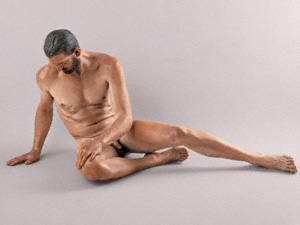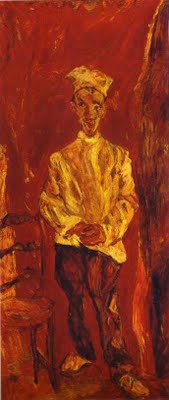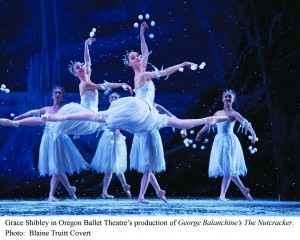 One of Art Scatter’s favorite blogs is Fifty Two Pieces, on which the erudite Amy and LaValle write about specific works at the Portland Art Museum and then let their minds wander into those strange and fascinating places that great art tends to nudge active minds. The blog is called Fifty Two Pieces because its authors declared from the get-go that they would write for one year only.
One of Art Scatter’s favorite blogs is Fifty Two Pieces, on which the erudite Amy and LaValle write about specific works at the Portland Art Museum and then let their minds wander into those strange and fascinating places that great art tends to nudge active minds. The blog is called Fifty Two Pieces because its authors declared from the get-go that they would write for one year only.
Time’s running short, so get your fresh links while they’re still hot off the grill. Amy and LaValle began their excellent adventure on New Year’s Day 2009 with a consideration of John De Andrea‘s fabulous hyperrealist sculpture The Dying Gaul.
 Their latest consideration is another of my favorites at the museum, Chaim Soutine‘s charming, red-and-orange-soaked painting (it reminds me of cinnamon) The Little Pastry Chef. It’s inspired, among other things, this delicious musing on Fifty Two Pieces:
Their latest consideration is another of my favorites at the museum, Chaim Soutine‘s charming, red-and-orange-soaked painting (it reminds me of cinnamon) The Little Pastry Chef. It’s inspired, among other things, this delicious musing on Fifty Two Pieces:
“According to the encyclopedia of gastronomy, Larousse Gastronomique, as early as the Neolithic Age, prehistoric man made foods based on honey, fruits, seeds, and maple or birch syrup. It’s thought that Mediterranean baklava and filo are the original pastries, made in Assyria on special occasions and for the rich. Medieval crusaders to the Middle East brought the recipes for these sweet treats back with them upon their return to Europe. Over the next century, according to FoodTimeline.org, French and Italian Renaissance chefs perfected puff pastry to an art form, adapting these original recipes to create Napoleons, brioche, éclairs and cream puffs.”
Today the blog considers the similarities between The Little Pastry Chef and Morris Graves‘ Portrait of Bill Cumming, which hangs nearby. Soutine and Graves aren’t names you’d ordinarily through together in the same beret, but there you go: Art loves strange hatfellows.
LaValle, by the way, has been gadding about Berlin lately, and recording her impressions on her own blog, Two to Europe. She’ll be back. In the meantime, Amy’s holding the fort just fine.
A few other things we’ve enjoyed reading lately:
- Grant Butler’s interview with James E. McWilliams, author of the new book Just Food: Where Locavores Get It Wrong and How We Can Truly Eat Responsibly, in the FoodDay section of The Oregonian. Butler and McWilliams bring some welcome nuance to the whole question of eating locally (McWilliams suggests not making it a religion) and raise the issue of feeding a hungry world, not just our little agriculturally blessed corner of it. The story brings up the work of Norman Borlaug, the “green revolution” pioneer who died this month at 95 (his New York Times obituary is here) and whom Art Scatter wrote about last year in a long piece that began with Leo Tolstoy.
- Stephen Holden’s review in the New York Times of the “vaudevillian spark plug” Jason Graae’s new cabaret act. Holden’s running series of pieces on New York’s cabaret scene and its link to the Great American Songbook is a pure pleasure. Graae is apparently a mischievous sort, and Holden reports straight-faced on his closing number Slasher Medley: “It was a surefire piece of special material that stitched together revised quotes from Broadway standards: ‘Gray skies are going to clear up/Carve up a happy face’; ‘If ever I would cleave you, I’d start around the elbow.’ My favorite: ‘When you walk through a storm, hold a head up high.’“
- Jon Michael Varese’s impassioned argument in The Guardian (via Arts & Letters Daily), Why Are We Still reading Dickens? The old Victorian cliff-hanger specialist has had his critical ups and downs, but no matter what the fashion of the moment, he keeps hanging on — and we keep hanging on to him. For extremely good reason, Varese argues. Dickens, he concludes, is “shining a light on who I am during the best and worst of times.”
 The news today isn’t good, and it isn’t unexpected:
The news today isn’t good, and it isn’t unexpected:  On a lighter note, a trip to North Portland for a puppet show got me thinking about the great ecdysiast Gypsy Rose Lee, she of the most celebrated stage mom in show business. (That would be Momma Rose, in the musical Gypsy.) You can see the results of my puppet adventures, as related in Monday’s Oregonian,
On a lighter note, a trip to North Portland for a puppet show got me thinking about the great ecdysiast Gypsy Rose Lee, she of the most celebrated stage mom in show business. (That would be Momma Rose, in the musical Gypsy.) You can see the results of my puppet adventures, as related in Monday’s Oregonian,